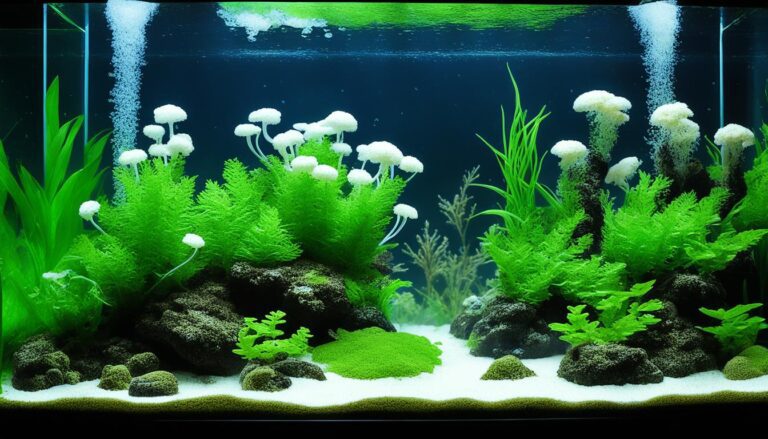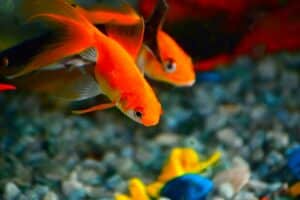Did you know that freshwater aquarium fish are more prone to fungal infections (a.k.a fish fungus) than their saltwater buddies? That’s because most water molds can’t survive in saltwater, so keeping your freshwater fish free from fungal outbreaks is super important for a healthy tank. Watch out for signs like pale gills, fluffy patches, or even sudden death in your fish—these could be clues that something’s wrong and they need quick treatment.
If you want to avoid fungal diseases in your fish, the first step is figuring out what causes them. Issues often start with dirty tanks or poor nutrition, highlighting how much the tank’s condition affects your fish’s well-being. But keeping the water clean and preventing fights is just part of the puzzle—it’s really about taking care of the entire tank environment.
Having dealt with fungal diseases myself, I’ve learned that acting fast and making smart decisions is key. It’s not just about reaching for medication when you spot a white patch on your fish; it’s also about giving the tank a thorough cleaning. Scrubbing off algae, siphoning out waste, and doing regular water changes are all essential. Getting rid of those pesky fungal spores is crucial to keeping your fish and their home in tip-top shape.
I’ve found out a lot about fighting fungal problems in fish tanks. To really prevent them, you need to keep your tank clean and your fish happy. Prevention is better than cure. Providing a stable, well-kept home is the best way to take care of our fish friends’ world.
Symptoms of Fungal Infections in Aquatic Pets
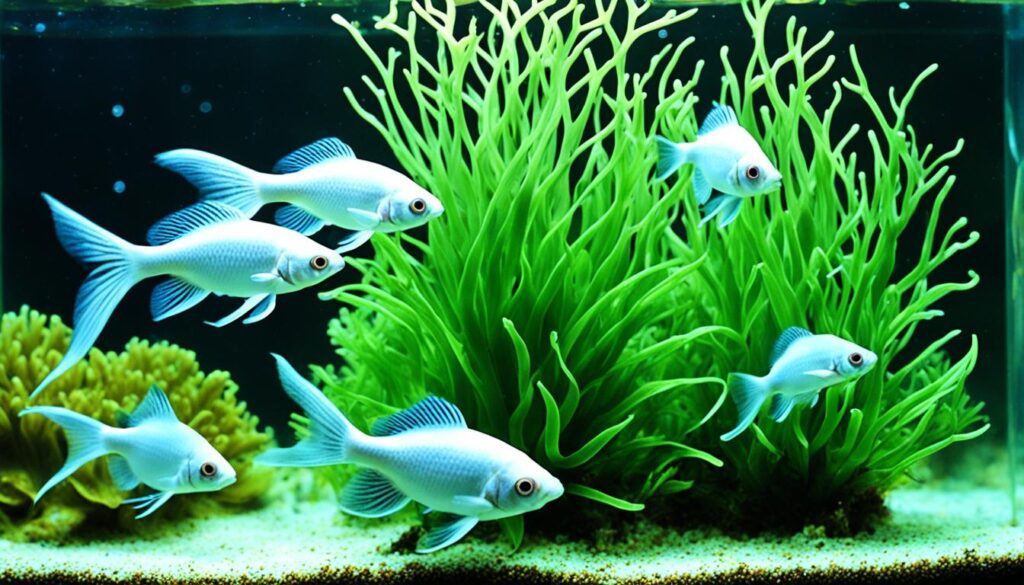
Spotting fungal infections early in aquarium fish is vital for their health. By noticing symptoms on time, you can treat them properly. This keeps the whole fish community in your tank healthy. Fish with fungal infections show clear signs through their looks and actions.
The first signs include white, cotton-like spots on the fins, mouth, and body. These spots mean a fungus has infected your fish. Fish might also have damaged mouth and head areas. This makes eating hard and harms their health even more.
Other signs involve fins looking torn, shabby, or fluffy, and they might have red lines. Watching how fish behave is also crucial in spotting fungal infections. You might see fish with closed fins, moving less, eating less, or staying still near the water’s surface or hidden in the tank.
Here’s a list of common fungal infection signs in fish:
Symptom |
Appearance/Behavior |
|---|---|
Cotton-like Tufts |
White patches resembling cotton around mouth, body, and fins |
Eroded Regions |
Rotted mouth and head areas complicate feeding and swimming |
Frayed or Fluffy Fins |
Fins appear tattered, possibly with blood streaks |
Behavioral Changes |
Lethargy, lack of appetite, clamped fins, motionlessness |
Knowing these signs of fungal infection in fish helps fish keepers act fast. This stops the infection from spreading. Catching these signs early is key to treating and healing sick fish successfully.
Common Causes Behind Fungal Infections in Aquarium Fish
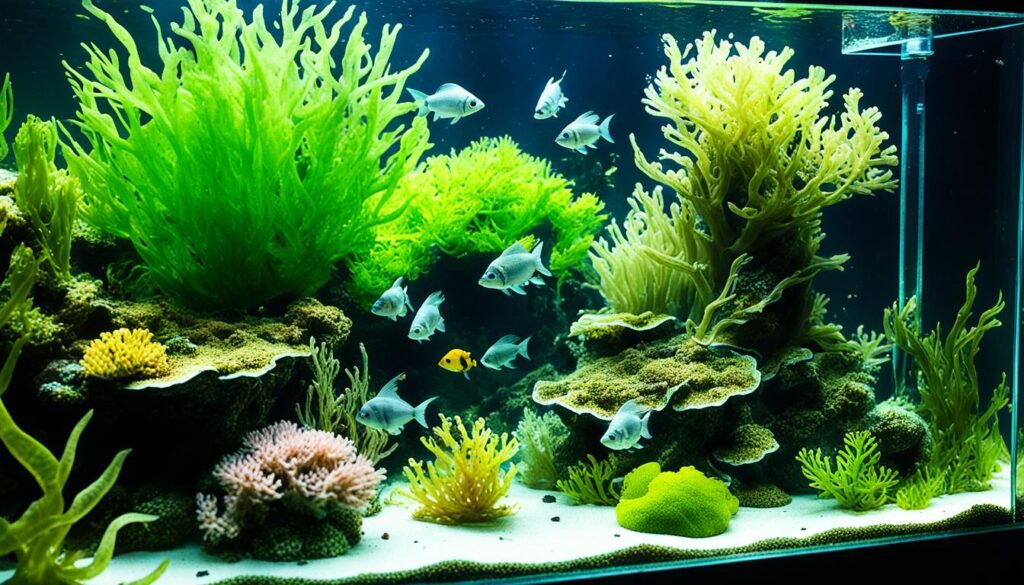
Knowing causes of fungal infections in fish is crucial for anyone with an aquarium. Many things lead to these infections, but aquarium water quality is key. Poor water can stress fish and make them more likely to get sick.
Stress from bad living conditions can make fish sick. For instance, bettas sometimes live in cold, small tanks. This is very different from their natural home, making them stressed and sick. Livebearers, like guppies, also face big changes after they are bought. This can make them get fungal infections.
A good diet is important for fish health too. Feeding them a variety of quality foods helps prevent sickness. A bad diet can make their immune system weak. Then, they can get diseases like cotton wool disease, mouth rot, and fin rot. These diseases are often linked to bad water conditions and other infections.
Condition |
Cause |
Treatment |
|---|---|---|
Mouth Fungus (Mouth Rot) |
Flavobacterium bacteria, poor water quality |
Anti Fungus and Finrot Medication, Aquilibrium Salt |
Fin Rot |
Poor water condition, secondary bacterial infection |
Anti Fungus, Disease Away, Water Quality Management |
Fungal Infections from Wounds |
Aggression, poor handling |
Medications containing malachite green and formalin, Water Quality Management |
Managing aquarium water quality well is very important. This means regular cleaning and checking the water. If something seems wrong, act fast. Reducing stress factors in fish disease and keeping the tank clean prevents causes of fungal infections in fish.
Treating Fungal Infections: Immediate Steps for a Healthy Aquarium
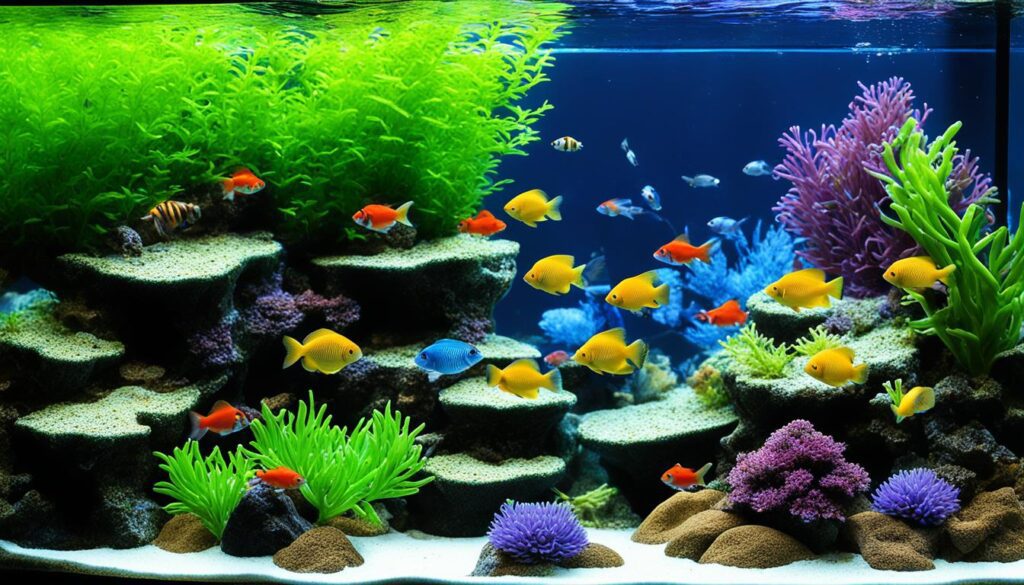
Dealing with fungal infections in your aquarium starts with a good aquarium cleaning. This action not only boosts fish health but also prepares the aquarium for more effective treatments. Let’s look at the initial steps to manage and treat these infections well.
Initial Aquarium Cleanup Strategies
Beginning with thorough aquarium cleaning is crucial. Removing debris, excess food, and other waste cuts down fungal growth chances. Follow this focused approach:
- Perform at least a 10-20% water change weekly, focusing on siphoning out waste materials that accumulate in the substrate.
- Clean the filter, decorations, and the inner walls of the tank without disturbing the healthy bacterial colonies that are beneficial for your ecosystem.
- Adjust water parameters to ideal levels, as maintaining proper pH, temperature, and mineral content can prevent many rare fungal diseases.
Special Considerations for Aggressive Fungal Strains
For aggressive fungal infections like Branchiomycosis in fish, quick action is needed. Quarantine infected fish in a small tank (10–20 gallons) to stop the disease from spreading. While some cases may need euthanization to halt wider contagion, always talk to a vet for the best solutions.
Ensuring Effective Medication Application
Right medication dosing is key for a successful fungal infection treatment. Use trusted products like Maracyn and Ich-X for powerful antibacterial and antifungal treatments. Here are some application suggestions:
- Before adding any medication, remove activated carbon from filters and halt UV sterilization to ensure medication efficacy.
- Dose according to instructions, factoring in the specific requirements of your tank’s volume and species affected.
- Monitor the health and behavior of your fish to adjust treatments as needed and prevent overdosing.
Preparation and Administration of Effective Treatments

Preparing and applying administering fungal infection treatments in home aquariums are key steps. They ensure the treatment works well and keeps our pets safe and healthy. Let’s go through how to get your aquarium ready and apply treatments correctly.
First, make the aquarium ready for treatment. This means removing any chemical filters like activated carbon, which can stop the medication from working. Do this step before you add any aquarium treatment preparations.
Next, measure the medication dose based on your aquarium’s size. Not using enough won’t beat the infection, and too much could hurt your fish. Getting the dose right is critical for success.
Keep an eye on water quality too. Make sure the temperature and pH levels are just right and steady. This is because changes can make medicines less effective and stress out your fish. That could slow down their recovery.
Now for putting the treatment into the aquarium. Follow the maker’s directions to dilute it, then add it slowly. This careful approach helps your fish adjust without shock.
While treating, watch your aquarium and fish for any bad reactions. Paying close attention lets you adjust things as needed quickly.
Finally, finish all the treatment as the instructions say. Stopping too soon, even if things look better, could let the infection come back.
Phase |
Action |
Purpose |
|---|---|---|
Pre-Treatment |
Remove chemical filters |
Ensures full efficacy of medications |
Dosage Preparation |
Measure according to tank size |
Optimizes treatment effectiveness and safety |
Medication Dilution |
Dilute as recommended |
Facilitates safe introduction to environment |
Monitoring |
Observe fish behavior and tank conditions |
Allows timely intervention if adverse effects appear |
Post-Treatment |
Complete prescribed medication course |
Prevents resurgence of infection |
So, dealing with administering fungal infection treatments means preparing well and following directions closely. This approach greatly increases recovery chances for our fish, making sure our aquariums stay healthy.
Maintenance Strategies to Sustain a Fungal-Free Environment

Good aquarium maintenance is key for a healthy fish environment and to stop fish diseases coming back. This means more than just clean water. It’s about creating a place where fish can thrive.
Testing water quality regularly is crucial. It checks the levels of pH, ammonia, nitrite, and nitrate are safe. Changing up to 30% of the water at once keeps the tank clean and the fish healthy. This helps stop fish from getting sick.
- Observation: Always watch your fish for signs they might be unwell. Things like being slow, scratching a lot, or swimming oddly can be warning signs.
- Dietary Management: Giving your fish the right food in the right amounts is important. Too much food can rot and make the tank dirty.
- Environmental Enrichment: Ensuring there’s enough space, places to hide, and changing lights can make your tank more like the wild. It helps keep your fish happy.
Using new methods to find fungal threats early is also vital, according to research. Catching problems early can stop them from hurting your aquarium.
Strategy |
Benefits |
Impact on Fish Health |
|---|---|---|
Regular Water Changes |
Keeps the water fresh and healthy |
Makes fish less stressed and less likely to get sick |
Quality Feed |
Keeps the fish well-fed without making the tank dirty |
Boosts their immune system and helps them fight off diseases |
Stress Reduction |
Changes things that cause stress |
Stops behaviors that could make fish get sick |
In the end, taking care of your aquarium the right way is crucial. It does more than prevent sickness. It makes sure your fish live in a vibrant, healthy home.
The Role of Aquarium Salt in Treating Fungal Infections
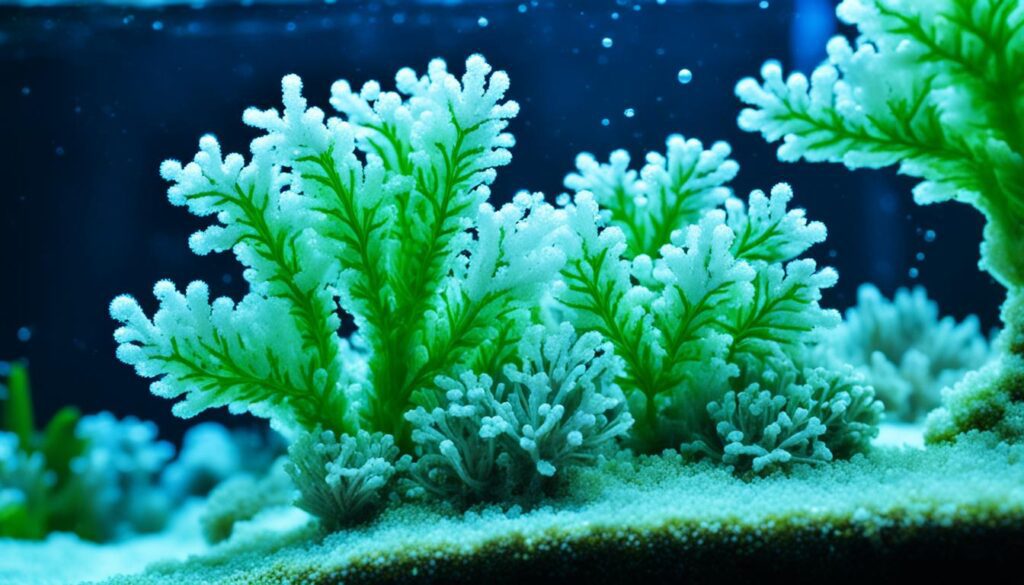
Aquarium salt is a key remedy for fungal infections in fish. It works well because it can kill a wide range of microbes. Knowing how much salt to use is important. It helps us protect the health of all fish in the aquarium.
Appropriate Dosage and Prolonged Treatment Timelines
A salt bath can effectively treat fungal infections if used correctly. Start with 1 tablespoon of salt for every 3 gallons of water for mild cases. For tougher infections, use 1 tablespoon per gallon. The treatment might need to last up to 2 weeks, depending on the infection’s severity.
After treating, do a 30% water change. This reduces the salt level and helps decide if more treatment is needed. It also keeps the fish from getting too stressed.
Salt Treatment Compatibility with Various Fish Species
Not all fish can handle the same amount of salt. For example, livebearers like mollies and guppies do well with more salt. This helps them move from brackish water to fresh water. But, some catfish are more sensitive. They need salt added slowly and careful watching during treatment.
Fish Species |
Salt Tolerance |
Recommended Salt Dosage |
|---|---|---|
Livebearers (Mollies, Guppies) |
High |
1 Tbsp/3 gallons |
Bettas |
Medium |
1 Tbsp/5 gallons |
Certain Catfish (e.g., Anchor Catfish) |
Low |
Gradual introduction necessary |
Using aquarium salt for fungal issues requires careful observation. Watching the fish’s behavior and health helps adjust the treatment. Properly used, a salt bath can greatly improve fish health and their home’s quality.
Herbal Remedies vs. Pharmaceutical Approaches
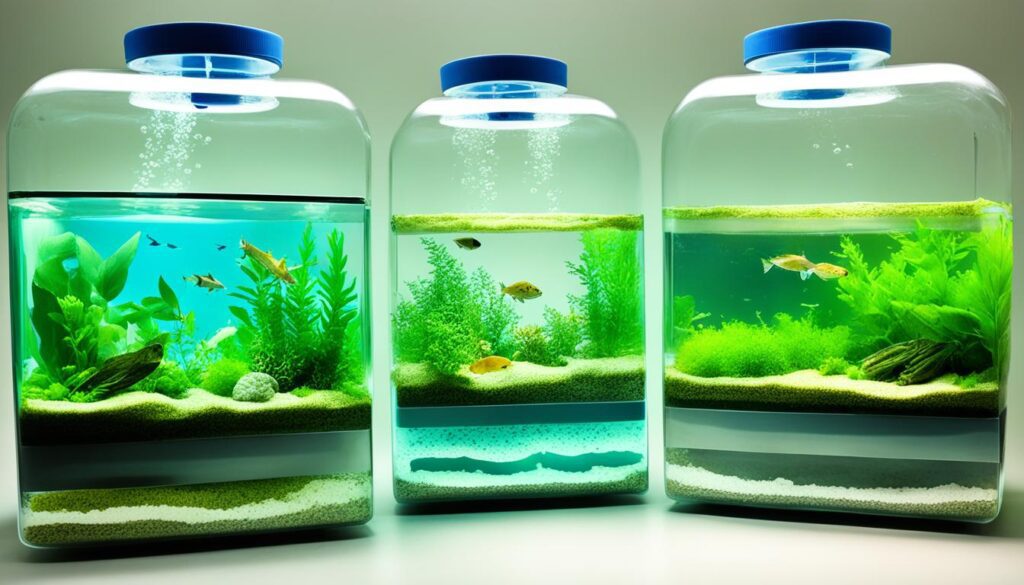
The debate on using herbal remedies versus pharmaceuticals for fish fungus focuses on their effectiveness, safety, and recovery speed. Many who love aquariums prefer natural herbal treatments. Yet, knowing the strengths and limits of each option is crucial.
Limitations of Herbal Treatments in Combating Fungal Infections
Herbal remedies like tea tree oil are popular for their natural roots. But, they face doubts about their effectiveness. Much research shows that herbal medicines haven’t been thoroughly tested in water settings. While some essential oils fight fungus, the quality and results of these tests differ a lot. This shows a big issue – natural cures can’t always offer fast, sure results like medical ones do.
Proven Pharmaceutical Solutions for Fish Fungus
For serious fungal infections in fish, certain meds often work better. Maracyn and Ich-X are favorites among fish owners globally. These drugs are well-researched and proven to beat fungal infections effectively.
- Maracyn – A broad-spectrum antibiotic fighting various fish diseases.
- Ich-X – Combines active ingredients that treat infections while protecting plants and animals in the tank.
These options are not just effective; they’re also easy to use for a healthier tank.
The table below shows key differences between herbal and pharmaceutical treatments, helping us see how they compare:
Treatment Type |
Effectiveness |
Application Ease |
Speed of Recovery |
|---|---|---|---|
Herbal Remedies (Tea Tree oil, Eucalyptus oil) |
Varied, less constant |
Easy, most fish are safe |
Usually slower |
Pharmaceutical (Maracyn, Ich-X) |
Very effective, reliable |
Simple, but dose carefully |
Quicker |
Preventive Measures for Fungal Infections in Aquariums
Keeping my fish tank healthy is super important. It keeps my fish alive and makes my room look peaceful. To avoid fungal infections and keep fish healthy, I make sure everything is clean. I always use high-quality water. Underground waters are my go-to because they’re usually cleaner and safer for my fish. While rivers and canals seem natural, they need good filtration to reduce parasites.
Before adding new fish, I quarantine them. This step is key to keeping sickness out. It’s not just about them fitting in. It’s about protecting all my fish from new germs. I always have API® FUNGUS CURE ready. It fights off fungal infections and some bacterial ones too. It starts working in just 48 hours, making my tank stronger against fungus.
When I deal with disease, I’m very careful. For example, I remove filters before treating the water. I also use nature’s help, like the cold of winter or heat of summer, to stop diseases. It’s important to watch out for predators and clean up dead fish fast. Sometimes, I use chemicals cautiously to keep the tank clean without harming it.
I believe prevention is better than cure. I work to keep my tank balanced and my fish happy. By being proactive, my fish stay healthy. This way, I hardly ever need to use my remedy cabinet.
